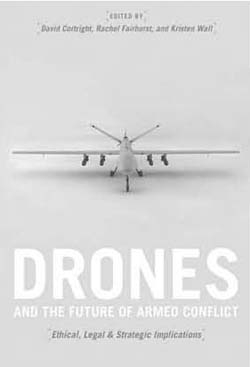Drones, or remotely piloted aircrafts, or unmanned aerial vehicles (UAVs), so to speak, have added a new dimension to the way war is conducted in the 21st century. Drones, besides being used as lethal weapons of war, have added functions of being instruments used for collection of intelligence and surveillance. Proponents of the use of drones in warfare, counter-terrorism and counter-insurgency believe that drones have made it possible to target the enemy without much collateral damage (civilian casualties). The added advantage of a drone is that not only can it hover over an area of operation for a long time, but also it does not require manpower in the line of fire, thereby removing the greatest limitations states face in war: body bags.
The book under review is an interesting take on the use of drones especially by the United States military. Several authors in the book debate on three significant aspects of the use of drones; the strategic, the legal and the ethical. Since weaponized drones were first used in November 2001 (p. 2), that killed senior al Qaeda leader, Mohammad Atef, their usage has only increased given the nature of counterterrorism that requires extended presence of drones to collect information. Shrouded in secrecy, the drones programme of the United States was only acknowledged in 2013 when President Obama gave a major speech announcing guidelines for the use of drones amidst criticism from lawyers and Human Rights activists on the programmes on subjugation of privacy and human liberty (pp. 3– 4). Reports of the use of drones in Pakistan and Yemen, and the subsequent civilian deaths from drone strikes raised the tempo of criticism. The secrecy connected to the US drone programme only heightens the view that its usage has compromised the laws of war and sovereignty of states guaranteed by the United Nations Charter.
With regard to the ethical dimensions of drone use, those who support it argue that the precision offered by its technology vindicates the discriminate use of force. This line of argument has been supported by Martin Cook’s essay (pp. 46–62) in which the author argues that drones are ethically permissible due to their tactical precision. Yet, this only enables states to use drones more indiscriminately given the assurance that these weapons systems are discriminate and proportionate, the classic inference from Jus in Bello (Right conduct in war) from the Just War theory. Also, since drones are being used increasingly in counter-terrorism where the intended target is usually in civilian areas, the argument that almost no civilian casualty will occur is rather hard to believe. This aspect has been brought out by Rafia Zakaria (pp. 199–212) when she argues that precision based drone strikes are not always discriminate as it is made out to be and demonstrates her argument through the case of Pakistan. The issue of state consent to drone attacks across territory is another important point of departure. Martin Cook asserts that since Pakistan has chosen not to shoot down US and CIA drones in its territory, this amounts to consent. This view is however contradicted by Chris Woods and Jennifer M. Welsh, who point out that the civilian parliaments, both in Pakistan and Yemen, have demanded that the US drone attacks on their territory cease (pp. 24–45–180).
The chapter writers are divided in their opinion as to the strategic effects of drones on counter-terrorism. Doubts have also been raised as to whether the use of drones actually comply with ethical and legal standards. The most critical issue is the use of lethal force outside the context of war, since weakening of the justification on the ‘use of force’ lends itself to wrong use. Jennifer Welsh has criticized the Obama administration for expanding the definition too broadly of who can be the target of drone strikes. Moreover, the ability to monitor drone strikes by an independent body is further compromised due to the secretive nature of the programme.

